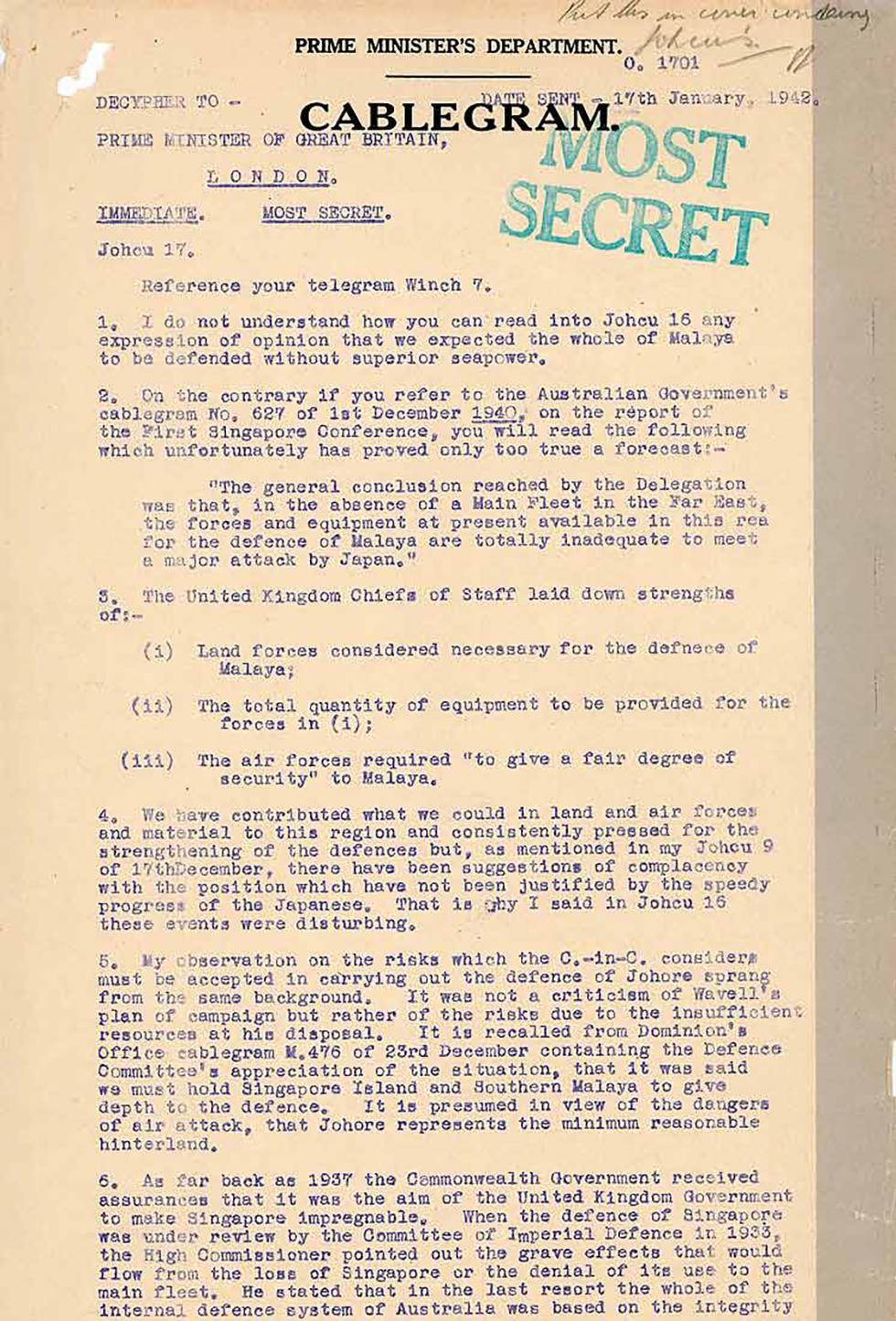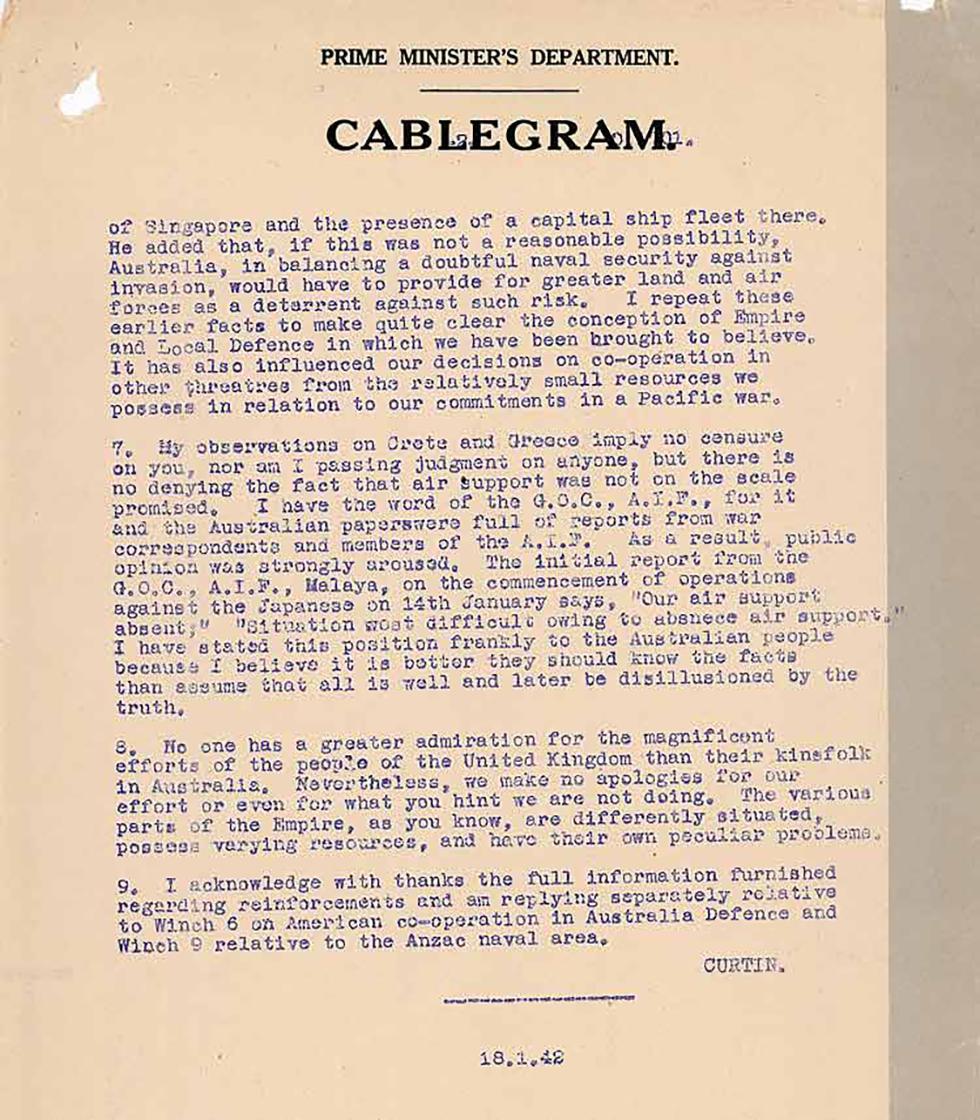

Aboriginal and Torres Strait Islander people should be aware that the National Archives' website and collection contain the names, images and voices of people who have died.
Some records include terms and views that are not appropriate today. They reflect the period in which they were created and are not the views of the National Archives.



[Page 1.]
[Letterhead: 'PRIME MINISTER'S DEPARTMENT.', 'CABLEGRAM.']
[Stamped in green ink in large letters: 'MOST SECRET'.]
[Handwritten annotation in top right corner:] Put this in cover containing Johcu's. [Illegible initial.]
0. 1701
DATE SENT – 17th January, 1942.
DECYPHER TO –
PRIME MINISTER OF GREAT BRITAIN,
LONDON. [underlined.]
IMMEDIATE. [underlined.] MOST SECRET. [underlined.]
Johcu 17.
Reference your telegram Winch 7.
1. I do not understand how you can read into Johcu 16 any expression of opinion that we expected the whole of Malaya to be defended without superior seapower.
2. On the contrary if you refer to the Australian Government's cablegram No. 627 of 1st December 1940 [underlined], on the report of the First Singapore Conference, you will read the following which unfortunately has proved only too true a forecast:-
[Indented quote:] 'The general conclusion reached by the Delegation was that, in the absence of a Main Fleet in the Far East, the forces and equipment at present available in this rea [sic – area] for the defence of Malaya are totally inadequate to meet a major attack by Japan.' [End quote.]
3. The United Kingdom Chiefs of Staff laid down strengths of: -
(i) Land forces considered necessary for the defnece [sic] of Malaya;
(ii) The total quantity of equipment to be provided for the forces in (i);
(iii) The air forces required 'to give a fair degree of security' to Malaya.
4. We have contributed what we could in land and air forces and material to this region and consistently pressed for the strengthening of the defences but, as mentioned in my Johcu 9 of 17th December, there have been suggestions of complacency with the position which have not been justified by the speedy progress of the Japanese. That is why I said in Johcu 16 these events were disturbing.
5. My observation on the risks which the C.-in-C. considers must be accepted in carrying out the defence of Johore sprang from the same background. It was not a criticism of Wavell's plan of campaign but rather of the risks due to the insufficient resources at his disposal. It is recalled from Dominion's Office cablegram M.476 of 23rd December containing the Defence Committee's appreciation of the situation, that it was said we must hold Singapore Island and Southern Malaya to give depth to the defence. It is presumed in view of the dangers of air attack, that Johore represents the minimum reasonable hinterland.
6. As far back as 1937 the Commonwealth Government received assurances that it was the aim of the United Kingdom Government to make Singapore impregnable. When the defence of Singapore was under review by the Committee of Imperial Defence in 1933, the High Commissioner pointed out the grave effects that would flow from the loss of Singapore or the denial of its use to the main fleet. He stated that in the last resort the whole of the internal defence system of Australia was on the integrity
[Page 2.]
[Letterhead: 'PRIME MINISTER'S DEPARTMENT.', 'CABLEGRAM.']
[Page number '.2.' Reference number '0. 1701.']
of Singapore and the presence of a capital ship fleet there. He added that, if this was not a reasonable possibility, Australia, in balancing a doubtful naval security against invasion, would have to provide for greater land and air forces as a deterrent against such risk. I repeat these earlier facts to make quite clear the conception of Empire and Local Defence in which we have been brought to believe. It has also influenced our decisions on co-operation in other threatres [sic] from the relatively small resources we possess in relation to our commitments in a Pacific war.
7. My observations on Crete and Greece imply no censure on you, nor am I passing judgment on anyone, but there is no denying the fact that air support was not on the scale promised. I have the word of the G.O.C., A.I.F., for it and the Australian papers were full of reports from war correspondents and members of the A.I.F. As a result public opinion was strongly aroused. The initial report from the G.O.C., A.I.F., Malaya, on the commencement of operations against the Japanese on 14th January says, 'Our air support absent,' 'Situation most difficult owing to absnece [sic] air support.' I have stated this position frankly to the Australian people because I believe it is better they should know the facts than assume that all is well and later be disillusioned by the truth.
8. No one has a greater admiration for the magnificent efforts of the people of the United Kingdom that their kinsfolk in Australia. Nevertheless, we make no apologies for our effort or even for what you hint we are not doing. The various parts of the Empire, as you know, are differently situated, possess varying resources, and have their own peculiar problems.
9. I acknowledge with thanks the full information furnished regarding reinforcements and am replying separately relative to Winch 6 on American co-operation in Australia Defence and Winch 9 relative to the Anzac naval area.
CURTIN.
18.1.42
This is a two-page cablegram sent on 17 January 1942 in which Australian Prime Minister John Curtin makes his views on the level of British commitment to the defence of Singapore clear to his British counterpart, Winston Churchill. Marked 'IMMEDIATE' and 'MOST SECRET', the cablegram refers to past conferences, discussions and assurances on the security of Singapore. While he praises the people of Britain for their magnificent efforts, Curtin makes no apology for raising the issue of British air support and for focusing on the defence of Australia.
Learning resource text © Education Services Australia Limited and the National Archives of Australia 2010.
Learn how to interpret primary sources, use our collection and more.
